
Original Link: https://www.anandtech.com/show/2332
Intel Developer Forum 2007 - Day 1: More Nehalem, Penryn Announced, and Gelsinger Speaks
by Anand Shimpi & Larry Barber on September 18, 2007 8:03 PM EST- Posted in
- Trade Shows
More Nehalem
When we published today's initial coverage we gave Nehalem very short treatment, simply due to a lack of time, but now that things have slowed down a bit we can touch on the gravity of today's Nehalem demonstrations.

We've talked in the past about Intel's incredibly strong roadmap and how it's firing on all cylinders, today's demonstration is perfect indication of that. Penryn isn't even out the door yet and Nehalem is design-complete, undergoing testing and already running two major OSes according to Intel.
We've yet to lay our hands on AMD's Phenom, much less give you more than a crude set of performance expectations based on server hardware, needless to say Intel is doing to AMD, what AMD did to Intel for years while the Pentium 4 struggled to perform.
Let's say that again: Intel is showing an architecture that won't be out until the end of next year, today.
A mere four hours after the first Nehalem demo, Intel was back with another one and this one, even more impressive. Nehalem uses Intel's new QuickPath interconnect, formerly known as CSI, and a direct competitor to AMD's Hyper Transport. Doing away with the Front Side bus and implementing a point-to-point interconnect is a huge feature of Nehalem, especially for the enterprise market, and Intel's second demo showcased just that.
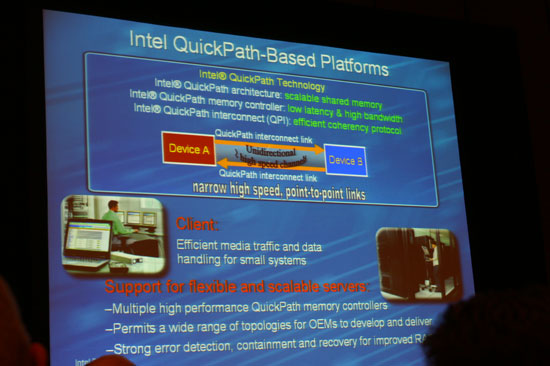
The second Nehalem system featured two quad-core Nehalem processors running in a two-socket system, the two sockets being connected via QuickPath.

Each quad-core Nehalem has SMT enabled, meaning each core can work on two threads simultaneously, so the entire box can simultaneously work on 16 threads as is evidenced by the obligatory task manager screenshot:
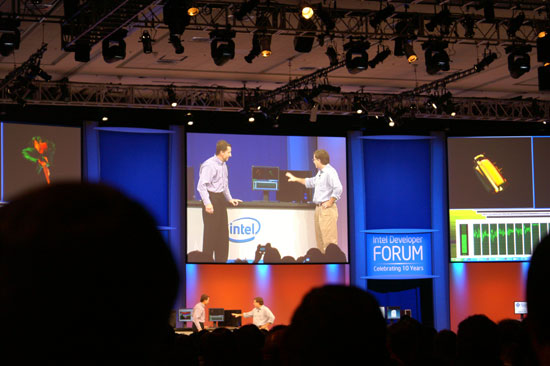
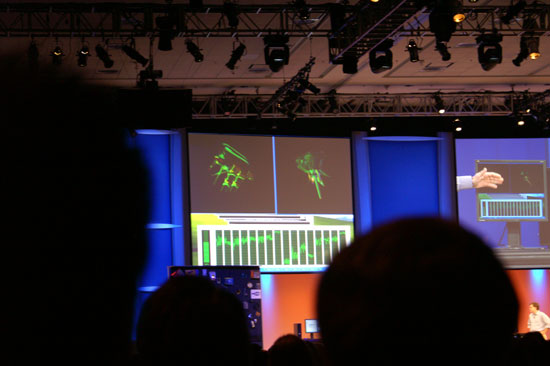
Obviously we have no performance data or clock speed information, we'd expect both to be quite low at this point but the fact that we're seeing the demo today is quite good. Despite worries of AMD being uncompetitive going forward, Intel seems to be proceeding according to plan, which is exactly what we want to see.

Nehalem will also add 7 new SSE4 instructions to its reportoire, note the diagram showing direct connections between processors and memory, very AMDesque

The Nehalem launch is a very important one for Intel as it is the first full repetition of its 2-year architectural cycle (tick-tock model); many wondered if Intel could pull it off, and we'll find out by this time next year.
The Transistor Issue: Nehalem Smaller than Penryn?
We published Nehalem transistor counts earlier today and wanted to clarify one point: the 731M transistor figure was for quad-core Nehalem. With quad-core Penryn weighing in at over 800 million transistors, there's a slight reduction in transistor count for Nehalem and the explanation is simple: cache size.
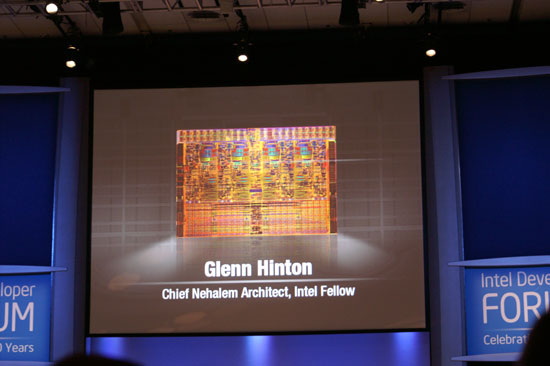
Quad-core Nehalem pictured above, supposedly 8-core versions are in the works
With Nehalem Intel could conceivably go to an architecture with smaller L2 caches per core and a large L3 cache to feed all four cores on the same die. High end Nehalem cores will also sport an on-die memory controller, reducing the need for a ridiculously large L2 cache, and thus we may see an overall cache size reduction going from Penryn to Nehalem while still yielding a performance increase.
The Core 2 Extreme QX9650: The First Desktop Penryn, November 12th
Intel announced details of its first quad-core Penryn (Yorkfield) processor, due out on November 12th - the Core 2 Extreme QX9650.
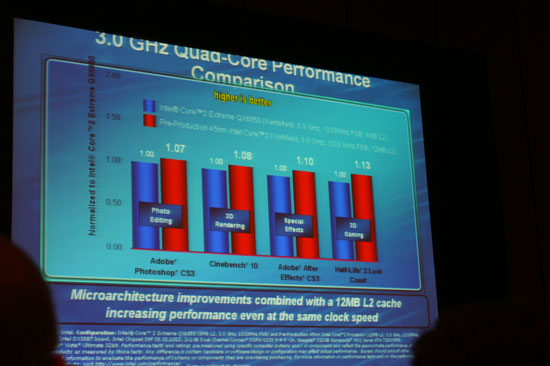
The QX9650 features four 45nm Penryn cores running at 3.0GHz with a 1333MHz FSB, and a total of 12MB L2 cache (6MB per two cores). Like all Extreme Edition processors, the QX9650 will ship unlocked.
Given the name, we'd expect to see it at the $999 price point of other top end Extreme Edition processors. The QX9600 will have the same 130W TDP as its predecessors.
Penryn SFF
In this morning's keynote Intel mentioned that it would be reducing CPU and chipset package size by the end of 2008 and we now have clarification on that statement. Intel's Montevina mobile platform due out in the second half of 2008 will offer small form factor versions of mobile Penryn, the Cantiga North Bridge and the South Bridge:
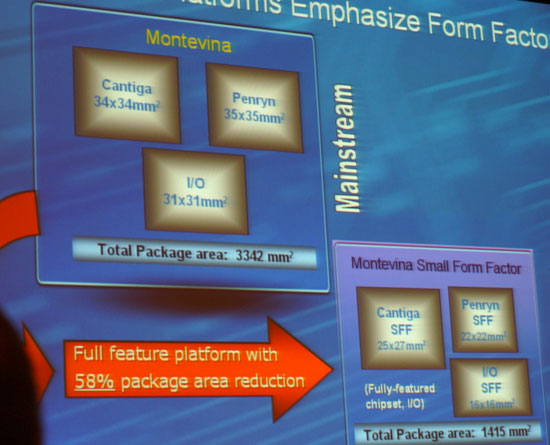
Silverthorne: In Person
We've talked about Silverthorne a few times recently, mostly around IDF announcements, but today we're able to bring you the first pictures of Intel's little engine that could.

Johan, extremely excited by Silverthorne, gets up close and personal with the wafer
Silverthorne is a brand new x86 design, intended to go after the ultra-mobile PC and consumer electronics markets. The core itself is extremely simple as it has to not only be low power but extremely low cost, the two major requirements for the CE market in particular.

Silverthorne is built on Intel's new 45nm process and according to Intel, will be able to work in devices with as little as 0.5W power consumption. You can expect Silverthorne and its derivatives to make their way into UMPCs, ultra small form factor notebooks as well as things like Digital TVs, HD-DVD/Blu-ray players and smart phones.

A close up of the Silverthorne wafer
Silverthorne, despite its already small size, needs to be even smaller in order to make it into things like the iPhone. We'd expect serious penetration into even smaller devices starting in 2009 with Intel's 32nm process.

My thumb, Intel's processor. Note: this is not an endorsement, we'll have to see how well it performs first :)
There's not much more we can provide on Silverthorne today, but expect to hear more about it tomorrow as the main topic of the day will be mobility.
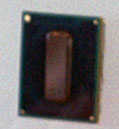
USB 3.0 and Intel's SSD
Gelsinger showed off two neat technologies during his keynote: USB 3.0 and Intel's Solid State Disk Drive.
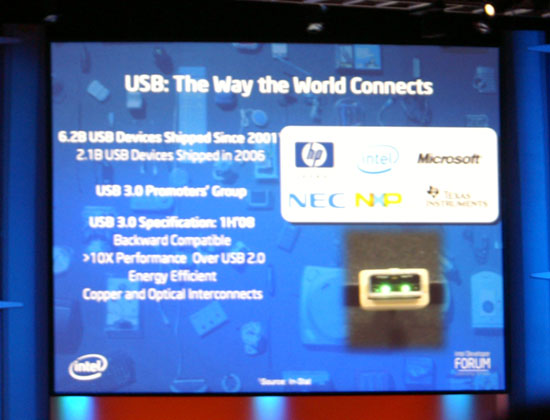
We apologize for the blurry picture, Johan made us late to the keynote and we had to sit in the back.
USB 3.0 will have around 10x the performance of USB 2.0 (we're assuming 10x the bandwidth?) and feature both optical and copper interconnects in order to provide backwards compatibility to previous USB devices. A huge strength of USB has been continued backwards compatibility so it's good to see that USB 3.0 won't break that.

With the price of Flash memory coming down and the density going up, it's no surprise to see Intel jumping in the Solid State Drive game with its Flash. You can expect to see Intel SSDs sometime in 2008, and Intel promises to use its experience to actually offer a performance advantage over the competition; we think it's possible if Intel designs the Flash-to-SATA controller itself rather than using the same off the shelf components that everyone else is using today. Controller performance ends up dictating overall SSD performance significantly as we've seen from current generation SSDs.
SkullTrail
Pat Gelsinger also briefly showed off SkullTrail, the successor to Intel's V8 platform. We'll have more details on SkullTrail later this week, so stay tuned.
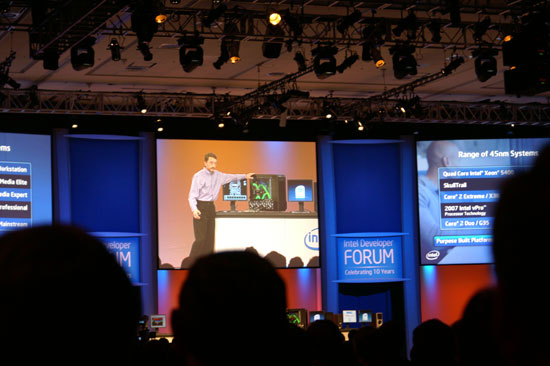
You'll remember the original announcement of SkullTrail from Intel's Beijing IDF, it's a two socket platform, designed for quad-core Penryn, with multiple x16 PCIe slots and FB-DIMM support.







